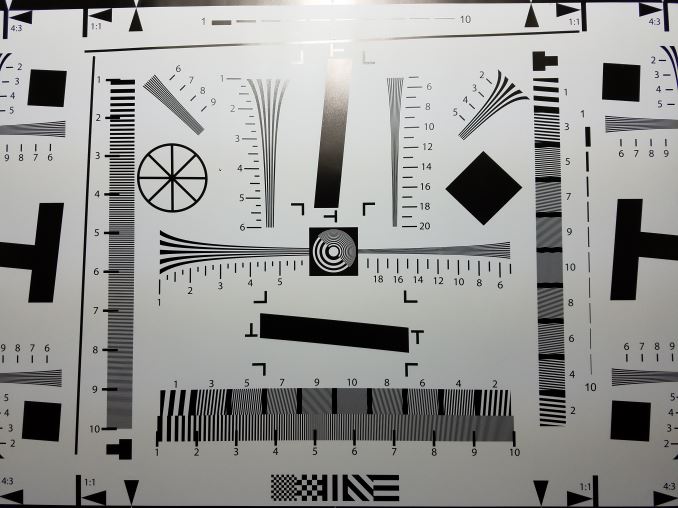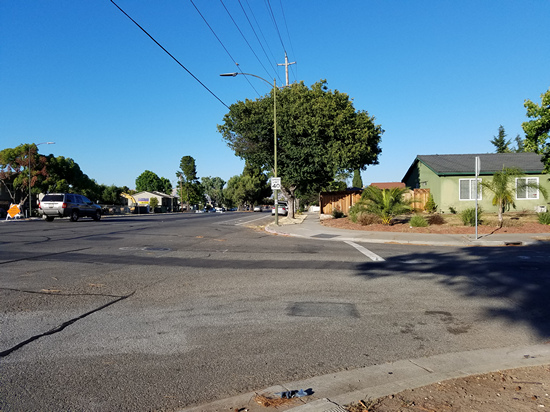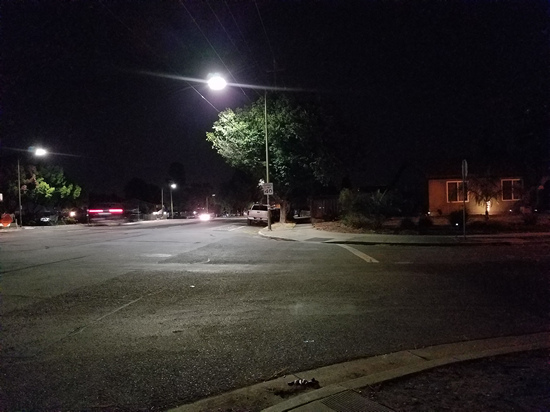The Samsung Galaxy S7 and S7 edge Review: Part 2
by Joshua Ho on July 5, 2016 8:00 AM ESTStill Image Performance
Now that we’ve covered the user experience associated with the camera, we can start to go over the output that the Galaxy S7 is capable of producing. In order to do this we continue to carry over the same sorts of benchmarks that we’ve used in 2015, which is to say that we use a combination of standardized test charts with semi-controlled lighting along with real world testing to try and see how the device actually performs outside of rather simplistic tests.
Starting with the ISO chart we can see quite clearly that the Galaxy S7 has lost noticeable ground in resolution relative to the Galaxy S6 when you look at the center of the photo, but at the edges of the photo the Galaxy S7 actually appears to have the lead against the Galaxy S6. The same sort of story plays out with the HTC 10 as it clearly has more detail than the Galaxy S7 at the center of the photo but the edges of the HTC 10’s test chart shot shows clear defocus that gets pretty terrible at the corners.
| Daytime Photography |
In our daytime landscape test we can see the sorts of effects that the smaller pixel size has had on the Galaxy S7. Relative to the Galaxy S6, there’s almost no delta in the detail resolved, but right away it’s obvious that the sharpening halos have become even more obvious than before which is concerning. These observations also apply to the Galaxy Note5, although the Note5 is a bit sharper due to some changes in image processing relative to the Galaxy S6. However I wouldn’t say that there’s an appreciable difference one way or another here.
Relative to the iPhone 6s, the Galaxy S7 is basically identical in detail as well, but the iPhone 6s tends a bit warmer and has much, much less obvious post-processing that is extremely obvious on the distant trees that contrast against the sky. This is actually kind of surprising for me given that the Galaxy S7 has a larger sensor, but I suspect the dual pixel AF, wider aperture, and slightly wider field of view are eliminating whatever advantages increased sensor size might bring.
Compared to the HTC 10, the Galaxy S7 has better edge contrast, but generally it looks like textures have better detail on the HTC 10. I haven’t been able to do extensive RAW comparisons yet but it looks like HTC is just blurring luminance noise out too aggressively here for whatever reason. I’m not sure what causes this in image processing, but given how other OEMs like LG and Apple are fully capable of mostly eliminating color noise from their photos while retaining most of the detail that their cameras are capturing HTC would do well to do the same.
The final point of comparison I want to make here is the LG G4/G5. Although the G5 seems to have started an AF run in the middle of the capture, the areas where the photo is actually focused are arguably better than what the Galaxy S7 can put out. Even next to the G4, the Galaxy S7 falls short. I’m honestly not sure why LG doesn’t get more credit here, because next to Apple they seem to have the best image processing algorithms in the industry.
| Low Light Photography |
While daytime quality is critical, I suspect most people are going to be interested in low light performance as this is usually the hardest test for any OEM to get through. It’s taken years for OEMs to start shipping acceptable image processing in low light that wasn’t just a smeary and oversharpened mess, so getting this right is pretty important to say the least.
Unfortunately, the Galaxy S7 is just a bit disappointing here. The LG G5 is just clearly better here as noise reduction is better in pretty much every way and it looks a lot more natural due to less obvious sharpening halos. I would also argue that the HTC 10 is also better here due to its better texture detail and better handling of shadow detail, even if edges are softer.
The Galaxy S7 also has this strange streaking light flare with bright sources that I just couldn’t get rid of despite wiping the lens multiple times with a clean cotton cloth, which was done for every phone in this test before taking the picture. In fairness, the Galaxy S7 is still the fastest camera out of everything in this test, but it comes at the cost of rather disappointing output for me. The Galaxy Note5 looks like it might even be slightly better than the Galaxy S7, which is a weird regression when the general idea of going to a larger pixel size is to get better low light performance. As alluded to earlier, the cost of the dual pixel AF system may be sensitivity due to the dual photodiodes and light barrier to generate a phase detection pixel. While this is just one test example I’ve spent a lot of time playing with the camera on the Galaxy S7 and in general its low light performance is fairly similar to what you see above. The only time where I really see the Galaxy S7 lead is in extreme low light conditions where everything is reaching ISO and shutter speed limits.
Overall, while the user experience of the Galaxy S7's camera is industry-leading, the Galaxy S7 represents a somewhat unfortunate sidegrade in camera quality at best. I would argue that Samsung has gone in the wrong direction with their camera processing as they seem to be relying on strong noise reduction and sharpening more than ever before. The Galaxy S7 also retains the oversaturated color rendering of the Galaxy S6. While I'm sure most people are happy with these results, Apple and LG tend to have more accurate color rendition with their cameras. While HTC doesn't quite nail color rendition, they are arguably closer to reality than Samsung is. Hopefully with their next device they manage to maintain their class-leading speed, but with better post-processing and overall image quality.



















266 Comments
View All Comments
realbabilu - Thursday, July 7, 2016 - link
If we bought for performance. The lags or the speed of apps is quite small than last one or two years ago oneplus one s801, you can't fell it big difference unless on benchmarking apps.The photos can tell different story, you can know it good or bad than last year mobile or other features like ois
ntp - Thursday, July 7, 2016 - link
That's a very thoughtful reply, Impulses, thanks. But with the small sensors of smartphones I think 3/4ths of a stop is a significant advantage, more so than in the case of large sensor cameras, since we'd care about the F number in low light scenarios, where the ISO will be high. I'm just saying it should be better emphasized so people understand the real world advantages it gives.Impulses - Thursday, July 7, 2016 - link
It's a valid point, I'm just saying you can't look at that in a vacuum, specially since you're not looking at an ILC anyway... If you can't swap any parts, then the end result is all that really matters and that includes sensor efficiency, post processing (unless you're shooting RAW, a rarity on phone users), the presence of OIS, effectiveness of the latter, and even things like how smart the auto mode is...That last bit is probably beyond AT's more data driven evaluation, but a phone that relies to heavily on OIS for instance (or HDR) might take more blurry shots under real life conditions... That actually does favor a faster aperture but the point is emphasising specs in a vacuum is pointless.
mavsaurabh - Tuesday, July 12, 2016 - link
I just wish to reply regarding aperture , you rightly said that f no causes cost to skyrocket in case of lslr ens all else being equal, the catchphrase is all being equal ! In case of constraints of mobile photography, lens stack size & weight limitations, heat produced etc leads to various compromises like plastic lens which coupled with bigger apertures leads to higher corner aberration, diffraction etc etc. in end as Impulses wrote what matters is the end result which is fine tuned balance of various compromises made !I am a pixel peeper and street, landscape photgrapher by hobby with 25 years of film and digital shooting through Slr's , mobiles , compacts, Fuji X100.
My observation is that samsung uses hard sharpening and over saturated colors which "creates" pleasing photos on phone screen but if you display it on decent monitor and zoom to even 50% you will see various artefacts and no latitude for post processing. Now most of casual photographers will like larger than life portrayal or smearing of face pimples etc by clever use of face detection but hey any one who loves photography will differ!
I completely agree about fast focussing advantages but honestly i am yet to use a mobile camera with lens fast enough to freeze pet/ child movement in indoor light to take advantags of fast focussing.
Only phone which was able to do that with use of proper flash though is Nokia 808 Pureview and kudos to its mazing manual controls plus superb post processing which bettered apple even in natural post processing !
beggerking@yahoo.com - Wednesday, July 6, 2016 - link
please just stop those BS apple biased benchmarks at 10x lower resolution... just take them off the chart! its not even a good comparision and serves no uses.realbabilu - Thursday, July 7, 2016 - link
What you see on your screen mobile is what you get. Offscreen just measuring the gpu can do,basically it useless for user because you can't see it.lilmoe - Wednesday, July 6, 2016 - link
"The one notable shortfall here is that Samsung only allows 800 ISO max in manual ISO mode when the true maximum is 1250"I had that number in mind when I read it last night, and was too lazy to test. I've tested it now and my unit can go up to 1600 ISO. Is that also a variable difference in Samsung's sensor (mine is Samsung made), or is the extra third stop on mine extended?
Chris_m1296 - Wednesday, July 6, 2016 - link
Joshua ho, how did the exynos 8890 manage this score on slingshot es 3.1 unlimited? mine only got 2223 and even 3dmark themselves list the exynos version at 2223.UtilityMax - Wednesday, July 6, 2016 - link
Some people complain that the review is too harsh. But my personal view is that if this is a +650USD smartphone that _also_ happens to be carrier locked, it'd better be not just good, but _excellent_ in every respect. Otherwise, it's not clear what exactly justifies the price premium over a phone like Oneplus 3 or why a typical shopper should choose this over an apple product.Impulses - Thursday, July 7, 2016 - link
I kinda agree... I still feel some areas could've been better tested given how long the review date got dragged out, but there was still content here that's pretty unique to AT. I think the market, overall, is definitely giving the high end OEM too much of a pass given the prices phones are now commanding.A $1,000+ laptop with performance sapping bloat that the user can't remove (that aren't part of the core OS) would get ripped to shreds. It's time $700+ phones were held to the same standards.